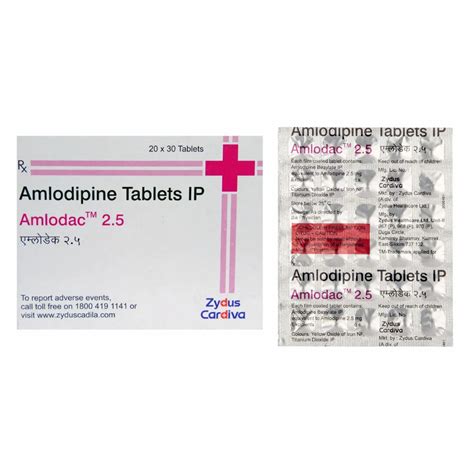Intro
Learn about Amlodipine 2.5 Mg dosage, side effects, and interactions. Understand blood pressure management, hypertension treatment, and cardiovascular health with this medication guide.
Amlodipine, a medication belonging to the class of calcium channel blockers, is widely used to treat hypertension (high blood pressure) and coronary artery disease. The dosage of amlodipine can vary based on the patient's condition, age, and response to the medication. One of the common dosages prescribed is amlodipine 2.5 mg, which is the focus of this article. Understanding the proper use, benefits, and potential side effects of amlodipine 2.5 mg is crucial for effective management of cardiovascular health.
The importance of managing high blood pressure cannot be overstated. Hypertension is a significant risk factor for heart disease, stroke, and kidney disease. By controlling blood pressure, individuals can significantly reduce their risk of developing these conditions. Amlodipine works by relaxing the blood vessels, making it easier for the heart to pump blood, which in turn lowers blood pressure and increases oxygen supply to the heart. The effectiveness of amlodipine in managing hypertension and its related conditions has made it a commonly prescribed medication worldwide.
For patients starting on amlodipine, the initial dosage often recommended is 2.5 mg once daily, which can be adjusted based on the patient's response to the medication. This flexibility in dosage allows healthcare providers to tailor the treatment to the individual needs of each patient, maximizing the benefits while minimizing potential side effects. The goal of treatment with amlodipine is not only to lower blood pressure but also to reduce the risk of cardiovascular events such as heart attacks and strokes. By understanding how amlodipine 2.5 mg works and how it can be integrated into a comprehensive treatment plan, patients can better manage their condition and improve their overall health.
Amlodipine 2.5 Mg Mechanism of Action

Benefits of Amlodipine 2.5 Mg
The benefits of amlodipine 2.5 mg are multifaceted, including its effectiveness in lowering blood pressure, reducing the risk of heart disease, and alleviating symptoms of angina. Additionally, amlodipine has been shown to have a protective effect on the kidneys in patients with diabetes, further highlighting its importance in comprehensive cardiovascular care. Its once-daily dosing makes it convenient for patients, improving adherence to treatment plans.Amlodipine 2.5 Mg Dosage and Administration

Potential Side Effects of Amlodipine 2.5 Mg
While amlodipine 2.5 mg is generally well-tolerated, it can cause side effects in some patients. Common side effects include headache, dizziness, nausea, and edema (swelling of the ankles, feet, and hands). These side effects are usually mild and temporary, resolving on their own or with adjustments in dosage. However, if side effects persist or worsen, patients should consult their healthcare provider for guidance.Amlodipine 2.5 Mg Interactions and Precautions

Practical Tips for Taking Amlodipine 2.5 Mg
To get the most benefit from amlodipine 2.5 mg, patients should: - Take the medication at the same time every day to maintain consistent levels in the blood. - Monitor blood pressure regularly and report any changes to the healthcare provider. - Avoid stopping the medication without consulting a healthcare provider, as this can lead to a rebound effect and worsen hypertension. - Maintain a healthy lifestyle, including a balanced diet, regular exercise, and stress management, to complement the effects of the medication.Amlodipine 2.5 Mg in Special Populations

Statistics on Amlodipine Usage
Amlodipine is one of the most prescribed medications for hypertension worldwide, with millions of patients benefiting from its use. Studies have shown that adherence to amlodipine therapy can significantly reduce the risk of cardiovascular events, highlighting the importance of patient compliance and proper dosage management.Future Directions in Amlodipine Therapy

Conclusion and Final Thoughts
In conclusion, amlodipine 2.5 mg is a valuable medication in the management of hypertension and coronary artery disease. Its effectiveness, combined with its relatively favorable side effect profile, makes it a commonly prescribed medication. By understanding the mechanism of action, benefits, and potential side effects of amlodipine 2.5 mg, patients can work closely with their healthcare providers to achieve better control of their blood pressure and reduce the risk of cardiovascular disease.What is the primary use of amlodipine 2.5 mg?
+Amlodipine 2.5 mg is primarily used to treat hypertension (high blood pressure) and coronary artery disease.
How should amlodipine 2.5 mg be taken?
+Amlodipine 2.5 mg should be taken orally once daily, with or without food, as directed by a healthcare provider.
What are common side effects of amlodipine 2.5 mg?
+Common side effects include headache, dizziness, nausea, and edema (swelling of the ankles, feet, and hands).
We invite you to share your thoughts and experiences with amlodipine 2.5 mg in the comments below. If you found this article informative, please consider sharing it with others who might benefit from this information. Your engagement and feedback are invaluable in helping us create more relevant and useful content for our readers.
